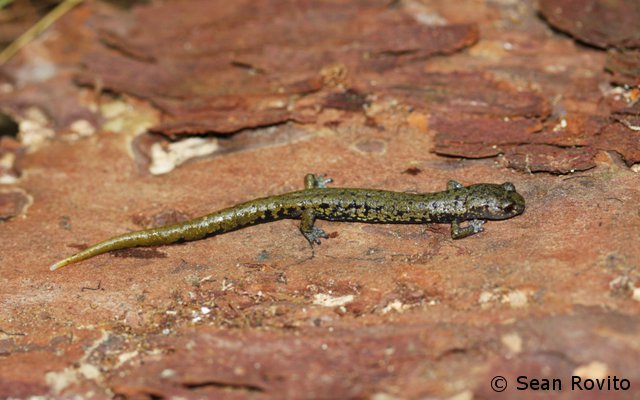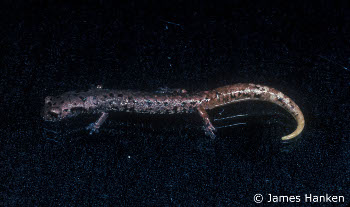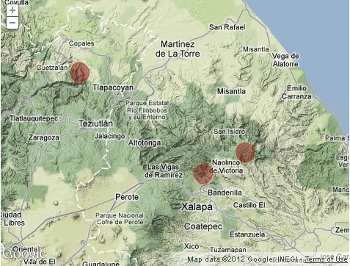As it was St Patrick’s Day last saturday, we thought we should pay homage and carry on the ‘green theme’ in our species of the week blog. So, here we present to you the Veracruz green salamander (Pseudorycea lynchi), number 89 on our top 100 EDGE amphibian list.

It belongs to the Plethodontidae family (also known as lungless salamanders), which diverged from other amphibians about 145 million years ago. Plethodontids are very different to most other salamanders because they don’t have any lungs, breathing entirely through their skin. As a result they have to have a long, slender body to maximise the oxygen they take in from the air around them, and some species have been known to grow over 300mm. They also have to keep moist, so are confined to humid areas and emerge in wet weather at night. The Veracruz green salamander is thought to be closely related to another top 100 EDGE species: the black spotted salamander (Pseudoeurycea nigromaculata).

The plethodontids have a narrow groove running from each nostril to the lip which carries water-bourne odours from the ground into the nose, allowing them to smell via water. Lungless salamanders can also influence the behaviour of other members belonging to the same species by releasing chemicals called pheromones from modified glands near their chins. Their flexible tails can be used as a fifth limb to grip with and hang from, especially in tree-dwelling species.
Sometimes false brook salamanders are seen without tails, as they have an unusual ability to detach them to escape predators and then grow them back again. They have other defence mechanisms such as noxious skin secretions and the use of a poisonous gland on the back of the head. If all else fails, plethodontids can play dead, coil and flip their bodies, and bite their attackers.
The Veracruz green salamander is ground-dwelling and occurs in cloud forest where it has been found in, or under, decaying wood and under log bark. This species also survives in degraded forest and rural gardens, and has even been found in rubbish heaps. It is only known from three populations in Mexico, and used to be found widely but a brief search in 2003 of one of its localities, Cerro San Pedro Chiconquiaco, was not successful in locating the species at all.

As it is currently listed as Critically Endangered by the IUCN, it is an urgent priority to protect some of the habitat of the Veracruz green salamander, yet there are no conservation measures being undertaken at present. Although this species seems to be able to survive in some human-modified areas and degraded habitat, the most important priority must be to ensure that its natural range is not destroyed by deforestation, mining, agriculture and invasive species. In addition, the IUCN has recommended that the Veracruz green salamander should have an ex situ (or captive) population established to guard against extinction.
Please help us save extraordinarily special animals like the Veracruz green salamander by spreading awareness of the EDGE Programme and if you are a budding conservationist with a passion for this or any other EDGE species, please get in touch to find out how you can make a difference.
Keep checking back for more info on different EDGE species every week!